Upper Greenhouse Map
Move your cursor over the name of the plant group you want to visit,
then click to be transported down the page!

|

Soil Bed/Turtle World |
This is the ground bed, which means it has a soil floor. This is where
the Box Turtle hibernates in the winter by digging into the soil. On
the ground bed is a wet wall made of bricks with an automatic watering
system, planted with water-loving plants. back
to map
|
|
The box turtle eats hibiscus most of the
year. She contributes to the greenhouse by eating pests. |
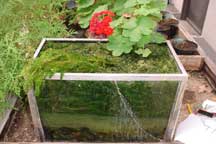
Elodea Tank |
Elodea is a submerged aquatic plant with thin leaves that
are used primarily in introductory biology classes. The thinness of the
leaves enables students to observe cytoplasmic streaming. back
to map |
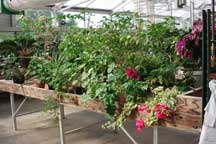
Class Plants |
Some of the biology classes require specific plants to be
grown for specific labs. The most common are peas, beans, and corn. The
general collection is also used for classes, and the higher light plants
are grown in the upper greenhouse. back to
map |
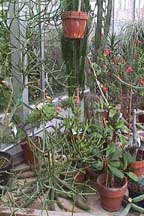
Succulents |
The succulents in the upper greenhouse are bigger than
those in the lower greenhouse. Most cacti are succulents, but not all
succulents are cacti. In the picture at right, the viny plant above/through
the round Mamalaria, is a succulent grape vine that is not a
cactus. back to map |
 Mamalaria
Mamalaria |
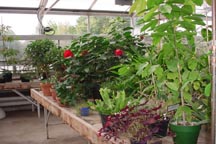
Permanent Collection
|
The permanent collection is split between the two greenhouses
with the more spectacular specimins in the upper "tourist" greenhouse.
This is also an insurance policy against accidental freezing in one greenhouse
or the other. back to map |

Papyrus Tank |
The Papyrus (Papyrus nanus) tank contains several
types of aquatic plants (and a rubber ducky) and goldfish (not shown). Some
of the other aquatic plants include water chestnut and aquatic liverwort.
back to map |
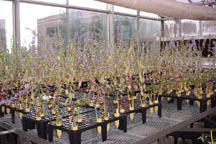
Research Area |
Current Projects:
The Craig/Itami/Etterson group is studying goldenrod (Soldago-see
picture at right) gall flies.
The Etterson group is studying plant evolution using Campanula (see
picture at left). back to map |
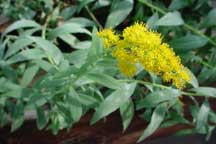
Solidago
|










